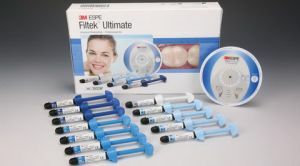 Filling material Filtek Ultimate refers to the light-curing composite materials of the new generation. It is used for sealing both the frontal and chewing groups of teeth.
Filling material Filtek Ultimate refers to the light-curing composite materials of the new generation. It is used for sealing both the frontal and chewing groups of teeth.
The composite has good radiopacity, which helps to correctly locate the installed seal.
For fixing Filtek in a carious cavity special adhesive systems are used. Materials from 3M ESPE company are the best.
A wide range of dentinal and enamel shades, a large number of universal color variants of "body" allow the material to be used on any teeth. Additional aesthetics are given with the transparent shades included in the kit.
Contents
- Composition and form of
- Composition kit Single Shade
- Evaluation kit Dual Shade
- Professional kit
- Material properties
- When
- is used Composition preparation
- Direct recovery method
- Direct repair method
- Special instructions
- Filtek Z250
- Differences in the
- Differences in the properties of
- Nanogybrid Z550
- Differences in
- Differences in
- properties Value of
- In conclusion
Composition and shape in
start in composition based on polymer resins lie. They are presented in several versions:
- Bis-GMA;
- UDMA;
- TEGDMA;
- PEGDMA;
- Bis-EMA.
The color of the seal is given due to the filler:
- non-aggregated silicon filler measuring 20 nm;
- non-aggregated zirconium filler 4-11 nm;
- dispersed zirconium and silicon cluster filler.
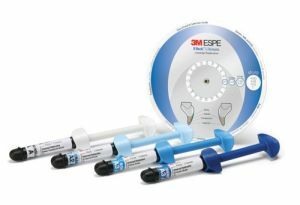 The particle size will depend on the kind of material itself. In enamel, dentinal shades and colors of "body" they will have a size of 0.6-10 microns.
The particle size will depend on the kind of material itself. In enamel, dentinal shades and colors of "body" they will have a size of 0.6-10 microns.
In transparent colors, the optimum value is 0.6-20 microns.
Composite is produced in the form of a syringe weighing 4 g. Buy them in different sets.
Single Shade inspection kit
The kit includes 2 syringes of A2 and A3 shades in the amount of 2 pieces, both Body. Also included is a technical instruction.
Evaluation kit Dual Shade
Includes 4 types of material:
- shades of dentine A3 and A4;
- shades of enamel A2 and A3.
Plus a scale is added to select the color of the material and the technical instruction.
Professional kit
Set consists of 12 shades:
- dentine colors A2, A3, B3;
- enamel colors of A1, A2, A3 and W;
- colors of "body" A2, A3, A3.5 and B2;
- transparent hue of AT.
A color scale and a technical instruction have also been added.
The fourth option is a separate syringe.
Material properties
According to the classification Filtek Ultimate refers to nanocomposites. The main properties of such a sealing material are:
- low shrinkage after light curing;
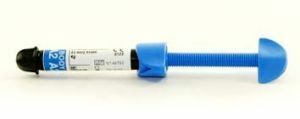
- excellent strength;
- sufficient wear resistance;
- plasticity;
- easy adaptation to carious cavity;
- good packing;
- good polishability;
- long-lasting gloss surface;
- effect of the "chameleon".
When using
This composite is recommended for use in the following cases:
- filling of carious cavities on all groups of teeth;
- superstructure of stump for future orthopedic construction;
- splinting of teeth in periodontitis;
- Indirect restoration of teeth, using tabs and veneers.
Preparation for the use of
Composite Initially, the teeth are cleaned using a brush and paste, then sanitation and professional cleaning are done.
Then you need to choose the color of the future seal. For this purpose, the standard VITA scale is used. To choose the right shade, the following recommendations should be observed:
- Since the tooth color is not homogeneous, it is divided into 3 parts, each of which has an individual shade. Restoration in the cervical region should be performed from a material that has a yellow tinge. The middle part is restored from gray, yellow or brown colors. The cutting edge should be made of gray or blue shades.
- The color saturation of the resulting restoration depends on the amount of material used. Than it will be less, the more transparent the seal will be. Depending on the amount of tissue that needs to be restored, and a tint is selected. You can select it in the part of the scale that coincides with the thickness of the future seal.
- After that part of the material is taken and applied to the place where the dental procedure will be performed. The composite polymerizes, and its shade is estimated under different light sources. Repeat this step until acceptable colors match.
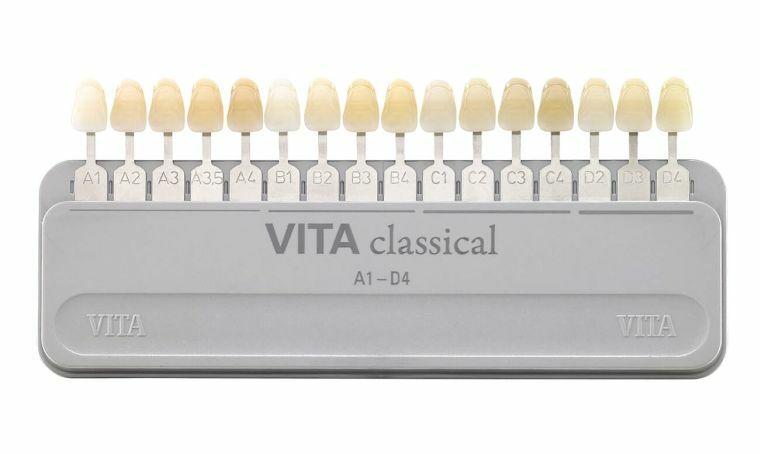
The final stage is the insulation of the working field with a cofferdam or cotton rollers.
These steps must be followed regardless of the type of recovery.
Direct recovery method
In this case, the following procedures are performed:
- carious cavity treatment;
- if necessary, a medical or insulating pad is applied to the bottom of the cavity;
- if restoration of contact between teeth is planned, the doctor sets the matrix;
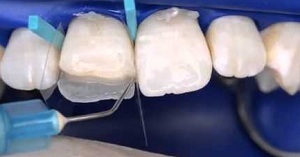
- etching enamel and dentine;
- application of the adhesive and its polymerization;
- the required quantity of filling material is extracted from the syringe and placed on a special notepad, then the syringe is closed with a cap and the notepad is covered with a protection against light;
- insertion of the composite into the prepared cavity should occur layerwise and tile;
- each layer is separately illuminated using a halogen or LED lamp with a light range of 400-500 nm;
- contouring of the seal with fins, burs or carborundum stones;
- verification of occlusion with articulatory paper and correction if necessary;
- final grinding and polishing of the seal.
Indirect restoration method
Indirect restoration of teeth:
- shade selection according to the above described procedure;
- tooth treatment for the selected design type;
- removal of the imprint and sending it to the laboratory;
- manufacture of gypsum models;
- preparation of the model of the processed tooth, a layer of separator is applied on it so that in the end the finished structure can be removed;
- layer-by-layer application of the composite on the tooth, the formation of its anatomy, contact points and polymerization( the procedure is the same as for direct restoration);
- polishing the design and checking on the model;
- in the clinic, the doctor checks the prosthesis in the patient's oral cavity and, if everything suits, then fixes it, in case of defects in color, shape and size, the design is returned to the laboratory for correction;
- creating roughness on the inner surface of the product;
- cleansing the prosthesis with a soap solution in ultrasound;
- then it is washed under running water and dried;
- at the end of the restoration is fixed on composite cement.
Special instructions
Storage of syringes should be at room temperature with a tightly closed lid. Shelf life - 3 years. It is necessary to completely eliminate the effect of light, since the material may lose its properties. Also, the composite should be away from products containing eugenol.
Because of the content of the polymer resin, there is a possibility of developing an allergy when in direct contact with the material. To reduce the risk of allergic reactions, use the composite in protective gloves, completely eliminating any contact.
After contact with skin, wash immediately under running water. If the material is on gloves, they are removed, and hands are treated with soap. Then put on new gloves.
Filtek Z250
Filling material 3M ESPE Filtek Z250 refers to micro-hybrid composites. It is also used for sealing all kinds of carious cavities.
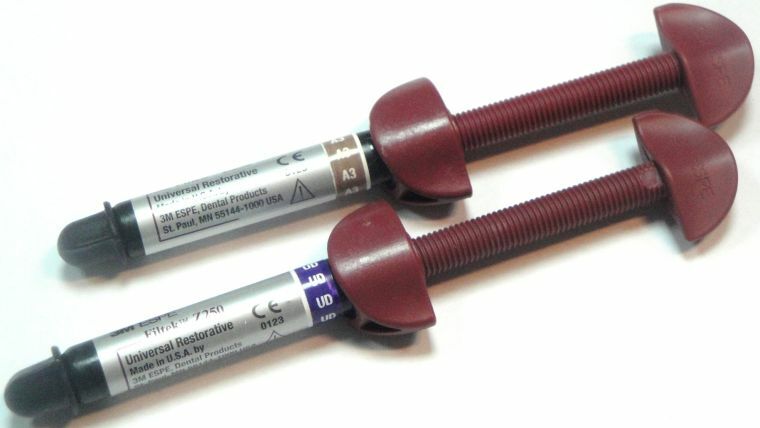
Differences in
Composite is also based on organic resin. Unlike the Ultimate series, only bis-GMA, UDMA and bis-EMA can be found in the composition.
In addition to the matrix, the Z250 series has a different filler. There are particles of 0.5-5 microns in size.
The form of release is a syringe of 4 g. The number of color variants is much smaller, there is no division into dentin, enamel and "bodi".
Differences in the properties of
This material also has the basic properties of composites, namely:
- satisfactory aesthetics;
- wear resistance;
- radiopacity;
- long-term preservation of the quality of the seal.
But because of the other filler size, the material has some disadvantages compared to the Ultimate series:
- higher shrinkage during polymerization;
- more complex application of material and its insufficient density;
- the quality of the restoration itself is lower;
- is less polishable;
- insufficient strength when used on complex and multi-level cavities.
Indication, use and precautions similar to the previous substance.
Nanohybrid Z550
This kind of composite belongs to nanohybrid materials.
Differences in
The Filtec Z550 contains particles of 0.5-5 microns in size and nanoclusters with a diameter of 0.6-10 nm. The basis is the same polymer resin as the Ultimate material.
Form - syringe 4 g.
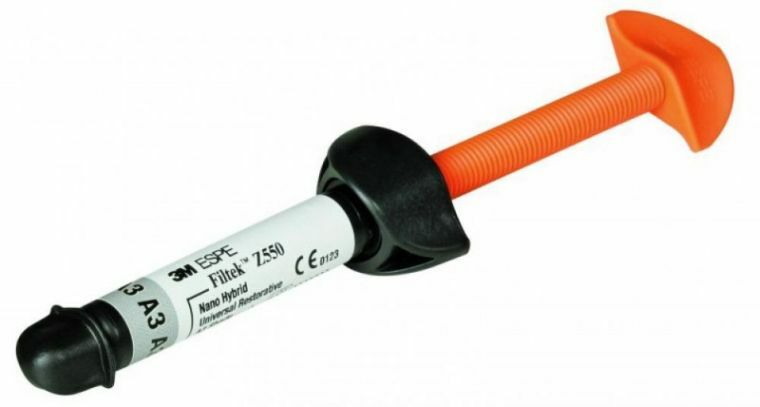
Differences in the properties of the
550 series is a modification of the Z250 series. From it, it is distinguished by added nanoparticles to the composition, which improved its some indicators:
- became stronger;
- has improved wear resistance;
- entering the cavity has become easier and more convenient;
- surface modeling of the seal became easier.
Still, the content of the mini-particles does not allow the Z550 to have the same high level of aesthetics as the Ultimate series. In addition, high shrinkage is retained after polymerization of the material. The degree of polishability of the material also differs. This composite will be slightly lower.
Indications for use, precautions and method of use correspond to the previous photopolymers.
Price
The price of the material will depend on the selected kit, with the maximum configuration, the cost of the Filtek Ultimate set is 22000-25000 rubles. The Single Shade and Dual Shade acquaintance kit will cost about 10,000 rubles.
The price for one syringe is in the range from 2300 to 2500 rubles.
In conclusion
The high aesthetics of the filling material allows it to be used on all groups of teeth. A large number of presented colors makes it easy to select the desired shade.
As a result, all the restored teeth can not be distinguished from their own. Excellent handling properties greatly facilitate the work and reduce the time spent on restoration.
All seals retain their original appearance for a long time. With regular correction and polishing, she will stand much longer than her 3-4 years.
